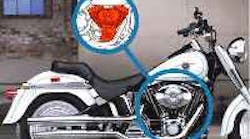Flexible manufacturing cells put Harleys on the road.
Instead of conventional machining centers, Harley-Davidson's Pilgrim Road Powertrain Operation incorporates Turmatic TriFlex manufacturing cells for cylinder-head and crankcase production.
A TriFlex UG machines the two halves (bolted together) of a Harley-Davidson TwinCam 88 engine crankcase.
At Harley-Davidson, TriFlex U flexible cells mill, drill, tap, and bore the rocker sides of TwinCam 88 cylinder heads in one fixturing.
Most companies would kill for the problem Harley-Davidson had between 1995 and 2000. Customer demand was so great that the motorcycle manufacturer had to double production capacity at its Pilgrim Road Powertrain Operation to keep up. The facility currently produces approximately 180,000 powertrains annually — the TwinCam 88 and 88B engines and transmissions. To meet this production level, Harley-Davidson bypassed the idea of adding more lines of its existing process technology. Instead, it opted for an alternative machining method for engine cylinder-head and crankcase production.
The Pilgrim Road facility now has nine Tri-Flex flexible manufacturing cells from Turmatic Systems of St. Louis: four U models, four UGs, and an MC4. According to David Shoals, manager of manufacturing support services at Harley-Davidson, the machines run three shifts a day, five to six days a week, and produce extremely high-quality parts with remarkable repeatability. "Because of their inherent accuracy," he says, "we've had to do little with respect to tooling and machine offsets to maintain tolerances and quality levels. This was not the case when we used horizontal machining centers to produce these same components."
TriFlex U systems do all the first operations on the TwinCam 88 and 88B cylinder heads. The machines, which have five 8-station turrets with 40 turret positions and 22 multispindle heads, are robotically loaded and unloaded. This frees the one operator per machine to spend much of his time monitoring the system and gaging parts.
TriFlexes handle five-sided machining at any of their four stations and sport the tool capacity for up to 56 separate operations. In effect, each automated TriFlex cell integrates multiple machining centers in a single footprint. "Cylinder heads are permanent mold aluminum," Shoals says, "and while there are few critically taxing tolerances, there are a great number of features machined."
All the milling, drilling, tapping, and boring for the rocker-arm side of the head is done in one fixturing. Fixtures are arranged so that each machine alternates between front and rear cylinder heads. Cycle time/part time is roughly 60 sec.
One of the challenges in this particular application is handling and fixturing. Parts are powder coated prior to machining; so once they are machined, the heads are too difficult to mask. This means fixturing, loading, and unloading must be accomplished without marring part finishes — a feat made possible by the precision of robot loaders and the predictable repeatability of the TriFlex systems, reports Shoals.
Improvements in productivity and quality clearly resonate in the cylinder-head application, says Shoals. "If we were to produce these cylinder heads on conventional machining centers, it would require 24 machines and seven different fixturings. We've gone from this scenario to two fixturings on four TriFlexes and from 384 fixtures to 16. The result is a greater volume of product with better productivity, higher quality, less scrap, and fewer required operators."
The horizontal machining centers the TriFlexes replaced have been retooled and are now producing other components. "We haven't scrapped out anything," remarks Shoals. "In-stead, we've simply amended our machining strategy."
Crankcases
Harley processes its vertically split TwinCam 88 and 88B crankcases in two stages. In the first stage, conventional machining centers work on crankcase halves separately. For the second stage, TriFlex UGs machine the two halves, which have been bolted together as a set.
"We used to process these cases complete on machining centers," Shoals says. "Today, a single TriFlex produces what seven machining centers did. So, we're getting the equivalent production of 21 horizontal machining centers from the three UG cells. Plus, we've all but eliminated variability and scrap." Crankcase sets are die-cast aluminum; measure about 20-in. long, 12-in. high, and 12-in. deep; and weigh 35 lb. ABB robots load and unload the UGs. Operations include milling the cylinder deck and the transmission-mounting surface and boring the lifter bores, which are held to within 0.0005 in. Cycle time is roughly 2 1 /2 min.
Each TriFlex UG has four machining fixtures, which make for considerable production flexibility. "We can set up any fixture, or combination of fixtures, to handle the product mix of 88 or 88B crankcases," comments Shoals. "Normally, we operate on a five-day fore-cast; however, if we had to change the mix suddenly — due to a spike in demand, for example — we could do it shift by shift. Actual changeover time is 20 min or less. With four fixtures and two types of crankcases, we can schedule almost chaotically, or very close to on-the-fly."
May The Best Machine WinHarley-Davidson management had considerable apprehension about changing its established cylinder-head and crankcase machining strategy. Although, the need for additional capacity was clear, the specific form of that increased capacity had to prove itself. Therefore, Harley devised a methodical approach to reach a purchasing consensus. Eleven machine tool builders were invited to Harley-Davidson on the same day. All aspects of the components to be machined — materials, features, tolerances, finishes, and volumes — were carefully reviewed. All 11 builders were given identical information, each receiving the same instructions, quote package, and deadline to respond. "We were careful to treat each supplier equally," says David Shoals of Harley-Davidson's Pilgrim Road Powertrain Operation, "and wanted no company participating in the bid process to feel it was at a disadvantage." |











